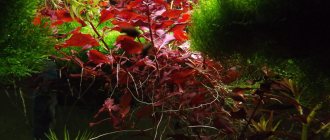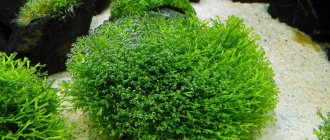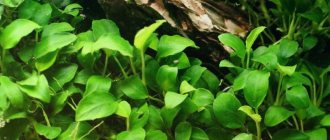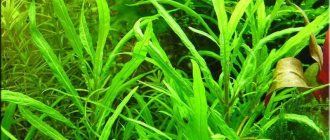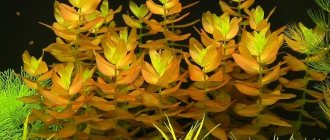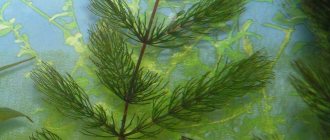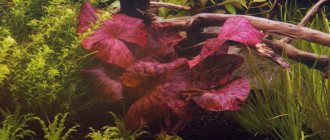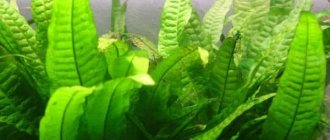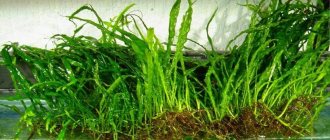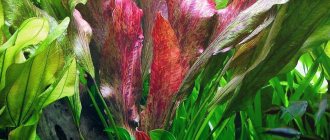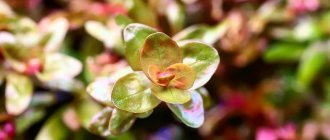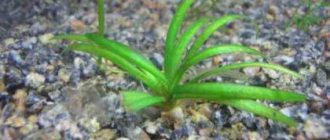Ludwigia is a tropical aquarium plant of the fireweed family. It has hundreds of varieties, differing from each other in size, color and complexity of content. Aquarists can choose Ludwigia to suit their taste, ranging from easy-to-care - swamp and creeping, which take root in almost any conditions, to the rare and whimsical Ludwigia white.
| Ludwigia | Temperature | pH of the environment | Hardness of water | Illumination | Aquarium size | Growth rate | Difficult to care for |
| Creeping | 4-28°С | 5.0-7.0 | 2–15°dGH | Medium\High | Big | High | Just |
| Bolotnaya | 4-28°С | 5.0-8.0 | 2–22°dGH | Medium\High | Big | High | Just |
| Mexico City | 4-28°С | 4.0-7.0 | 0-14°dGH | Medium\High | Big | High | Just |
| Glandular | 10–27°С | 5.5–7.0 | 2–10°dGH | High | Big | Average | Difficult |
| Red | 18-30°C | 5.0–7.0 | 0–8°dGH | High | Big | High | Difficult |
| Senegalese | 12-30°C | 4.0-7.0 | 0-7°dGH | High | Big | Average | Just |
| Ruby | 6-32°С | 4.0-7.0 | 2-15°dGH | Medium\High | Big | High | Just |
| Brevipes | 12-28°C | 4.0-7.0 | 2-10°dGH | Medium\High | Any | High | Just |
| Marilia | 20-28°С | 5.0-7.0 | 2-10°dGH | High | Any | High | Just |
| Arc-shaped | 12-28°C | 4.0–7.5 | 2-15°dGH | Medium\High | Any | High | Just |
| Inclinata | 22-27°C | 5.5-7.5 | 5-16° dGH | High | Big | High | Difficult |
| Peruvian | 22-27°C | 6,5-7,5 | 4-10° dGH | High | Big | High | Average |
| floating | 15-32°С | 6.0–7.5 | 2–15°dGH | High | Not suitable for aquarium | High | Difficult |
| Tornado | 18-30°C | 5.0–7.0 | 0–8°dGH | High | Big | High | Average |
| Ovalis | 10-28°C | 4.0–7.0 | 0–7°dGH | Medium\High | Big | High | Average |
| Pylos | 22-30°C | 6.0-7.0 | dGH 4-12° | High | Big | Low | Difficult |
Most popular types
Depending on the species, the color of Ludwigia leaves can be different, including with a red tint. Domestication has meant that they can be kept in a variety of environments, not just warm tropical waters. Some aquarists believe that the selected forms of plants differ little from each other, and the foliage gets a different shade due to the conditions of detention. There are also unpretentious species that are suitable for breeding by beginners:
Palustris or swamp - this species loves clean water and good lighting. Given the right conditions, it will grow quickly. If you decide to plant palustris in your aquarium, then the water in it should be 22-26 degrees, with hardness from 2 to 12, acidity from 6 to 7.5 pH.
Creeping or repens is distinguished by oval glossy leaves. Its color is dark green on top, and in the lower part near the stems it becomes reddish-purple. The plant reaches a length of 30-40 cm.
Inclinata Cuban - when transferred from its habitat to the aquarium, this variety changed its appearance: its leaves elongated and began to grow as close to each other as possible.
Super Red (Super Red) - this species differs from others in its unusual leaf color. They are red in color and do not lose the intensity of the shade due to insufficient light exposure. In specialized stores you can find this variety under different names; you can recognize it by its appearance.
The Peruvian or red star is a long-stemmed species suitable for an aquarium larger than 150 liters. Due to its length, the plant is planted only along the back wall, otherwise it will obscure the view. This species changes its color depending on the conditions in the aquarium, the upper part of the leaves is usually green or brown, and the lower part is red.
Tornado is an unusual variety bred in Vietnam. It has twisted leaves growing in whorls of thick stems. The plant will be tidy only with timely supply of fertilizers, a sufficient amount of carbon dioxide and reduced water hardness.
Arcuata or arcuate is a plant with a long stem and narrow leaves arranged in pairs. If you create the right conditions, the foliage will turn brown-red. The plant grows up to 30 cm in length. For normal development, it needs to warm the water to 22-27 degrees, keep its hardness between 1 and 20, and adjust the acidity parameter from 6 to 8 pH.
Ruby - This variety is often considered a subspecies of Super Red, as they are similar in foliage color. Ludwigia ruby is distinguished by a dense brown stem, large leaves 3 cm long and 2 cm wide, and changes in color if not properly cared for.
The floating one loves the most intense light - up to 1.5 W/l. It differs from other species in its elongated stem, reaching a length of up to 1 meter. Rounded leaves are attached to it in pairs, which can only exist on the surface of the water. If you try to “drown” the plant, its foliage will quickly die off.
These are the most beautiful and common Ludwigias in home aquariums. In total, there are more than 75 variants of this plant in the world.
Maintenance and care
| Lighting | °C | Carbonate hardness (°dKH) | Total hardness (°dGH) | PH |
| Moderate-Strong | 15-29 | 2-15 | 0-30 | 5-8 |
Red Ludwigia, of course, is not as hardy as Java moss or anubias, but if the basic maintenance requirements are met, it is quite easy to maintain. The most important requirement is, of course, good lighting. This plant will not grow in low light conditions, requiring at least 0.5 watts per liter of water to thrive. In brighter light the plant will grow faster and have much more intense leaf color. In order for the leaves of Ludwigia red to turn bright red, lighting of at least 0.75 - 1 watt per liter of water is required (possibly less in brighter lighting). Also, the plant should not be shaded, otherwise it may become unsightly and the leaves will begin to die. Although the application of CO2 is not necessary, its additives and fertilizers significantly improve growth and coloration. The addition of nitrogen, phosphorus and iron has a particularly beneficial effect on this aquarium plant.
Ludwigia can be uprooted by fish, so you should not keep it with fish that like to dig and dig up the soil. If you provide Ludwigia with good lighting and nutrition, then you will not have any problems with it, and soon you will need haircuts for correction.
Optimum temperature for normal growth: 23° - 27° C, medium to strong lighting, 0.5 to 1 watt per liter of water. The color of the leaves can be red even at 0.5 watts per liter of water, provided there is sufficient fertilizer and CO2. Additional requirements : it is desirable to add CO2 and fertilizers.
How to keep a plant
A feature of Ludwigia is its uniform development and growth throughout the year. This plant can be planted in an aquarium of any size. In large containers it is planted near the rear or side walls. It is necessary to create optimal tropical conditions:
| Conditions of detention | Recommendations |
| Climate | The optimal water temperature should range from 20 to 28 degrees. |
| Hardness and acidity | These water conditions are not particularly important for ludwigia. The plant tolerates weak acidic and alkaline environments well. With a hardness of more than 8 dH, the color of the foliage becomes more intense. |
| Updating fluid volume | It is recommended to change up to 30% of the total water volume once a week. |
| The soil | You can choose whether to root the plant or leave it floating on the surface. If you plant it in the ground, Ludwigia will develop faster. |
| Lighting | It must be diffuse. Aquariums located near a window or equipped with weak lamps work well. With this lighting, the redness will disappear from the leaves and a rich green tint will appear. They will look more attractive. If you choose fluorescent lamps, their power should be 0.5 W/l. You can add a 40 W incandescent lamp to the aquarium. The duration of light for Ludwigia should be at least 12 hours. |
Proper care allows the plant to develop as quickly as possible. You can determine whether you have truly created optimal conditions by the color of the leaves.
Description
The aquarium plant Ludwigia is found in many home ponds. It not only decorates the aquarium, but also creates an optimal microclimate for the fish.
Ludwigia stands out even in the herbal book!
Ludwigia belongs to the fireweed or onagraceae family. The plant's habitat is quite extensive: Central and North America, Africa, Asia, Europe. Ludwigia prefers warm waters and can grow both on land and in water.
Distinctive features of Ludwigia:
- straight, curved stem up to 0.5 m long;
- branched shoots;
- numerous leaves.
The size, shape and color of the foliage depend on the species of the plant and the conditions of its maintenance. The color of the leaf blades varies from light green to purple.
With proper care, Ludwigia can bloom above water, which allows you to create unusual compositions from it in the aquarium. The main thing is to create suitable conditions for the plant.
How to plant
It is best to plant this plant in low aquariums, since it develops better at low water levels. Aquarists plant ludwigias in different containers, focusing primarily on the inhabitants and the conditions of their detention.
Rooting of Ludwigia is not required. She can float freely on the surface of the water. If you nevertheless decide to plant it in the ground, then you need to select coarse sand with a small amount of silt. Please note that you should not plant Ludwigia in an aquarium that contains fish that like to dig in the soil - they will damage the root system.
It is permissible to use gravel, but only fine gravel. If its diameter is too large, the delicate roots of Ludwigia will be damaged. Be sure to mix the soil with fertilizer in the form of clay balls and special tablets. The nutritious part of the soil should cover the bottom of the aquarium by 3 cm, and gravel and sand should be laid on it. The total thickness of the pillow should be no more than 5 cm.
Aquadesign
Ludwigia repens is commonly used as a background plant to add a red accent to the aquarium. Several cuttings grouped together will create a beautiful red and dark green forest at the back of the aquarium. But with the right regular trims, it can be used in the middle part of the tank and even in the foreground of a large aquarium. If you cut off the top of the stem, side shoots will begin to grow from the base and the plant will become bushier in appearance. If you cut the bottom off, the stems will continue to grow upward instead of outward. In a large aquarium with very strong light, you can use this aquarium plant for the foreground and encourage bushy growth with trimmings. However, this option is only recommended for experts, since in strong light conditions you will have to do regular trimming to keep the plant at the bottom of the aquarium.
The most important thing is to never place this plant in shaded areas of the aquarium, since Ludwigia will stop growing and gradually simply disappear. Therefore, it is not recommended to plant it next to plants with broad leaves, such as Echinodorus amazonica.
Features of planting for greenhouses
If you have a paludarium or greenhouse with high humidity levels, you can make Ludwigia a ground plant. It can develop in such conditions if the air is very humid and the lighting is diffuse.
To plant ludwigia as a terrestrial plant, you must first place the cutting in a container with a low level of water. After it takes root and produces new stems, you need to place it in a pot with a nutrient mixture. Humus with sand, peat or garden soil are suitable.
Reproduction
If you want to plant ludwigia, then you need to separate a shoot at least 10 cm long from the stem. It can be immediately planted in the ground or left to float on the surface of the water until it takes root. After this, plant the plant.
Ludwigia quickly takes root and reproduces easily. This is why beginning aquarists love her. It is well suited for those who are going to make an additional aquarium for spawning fish. Roots appear on the shoots within a few days.
Useful lifehacks
To promote better plant growth, we offer advice from practicing aquarists:
- If the plant leaves its place, it may be obscured by neighboring aquarium crops.
- In coarse-grained substrate, Ludwigia roots do not develop, which leads to the development of diseases.
- Seashells, the surface of which is not varnished, look good in the herbal book with Ludwigia Marsh. Over time, they decompose and release minerals into the aquatic environment.
- This plant does not like deep-sea tanks. If the height of the water column exceeds 50 cm, the plant stretches and loses its decorative qualities.
- If you plant Ludwigia in a small, up to 20 cm, open tank, it quickly produces aerial shoots and blooms.
- To increase the intensity of the red color on the underside of the leaf blades, you can provide additional lighting using incandescent light bulbs.
Why isn't it growing?
There are several reasons why Ludwigia starts to get sick and stops developing:
- malnutrition;
- lack of lighting;
- too cold water in the aquarium;
- dirty water.
As soon as you eliminate the cause, the plant will begin to grow rapidly and change the color of the leaves. It is necessary to focus on the characteristics of the content of the Ludwigia variety, only then you will be able to admire the plant for a long time. Some species like harder water, others need it very warm, and the floating species is demanding on lighting.
Fertilizers
Most ludwigias are picky about fertilizers. They need special mineral supplements. The plant needs to be fed from the moment of planting; for this purpose, the soil is mixed with small clay balls.
One of the important elements for the development of algae is iron. It allows you to preserve the intense color of the foliage. It is especially important to add fertilizing with this element to the aquarium: if you have chosen a plant with red leaves, they need iron the most. It is recommended to regularly feed Ludwigia with mineral fertilizers; such complexes contain everything you need.
